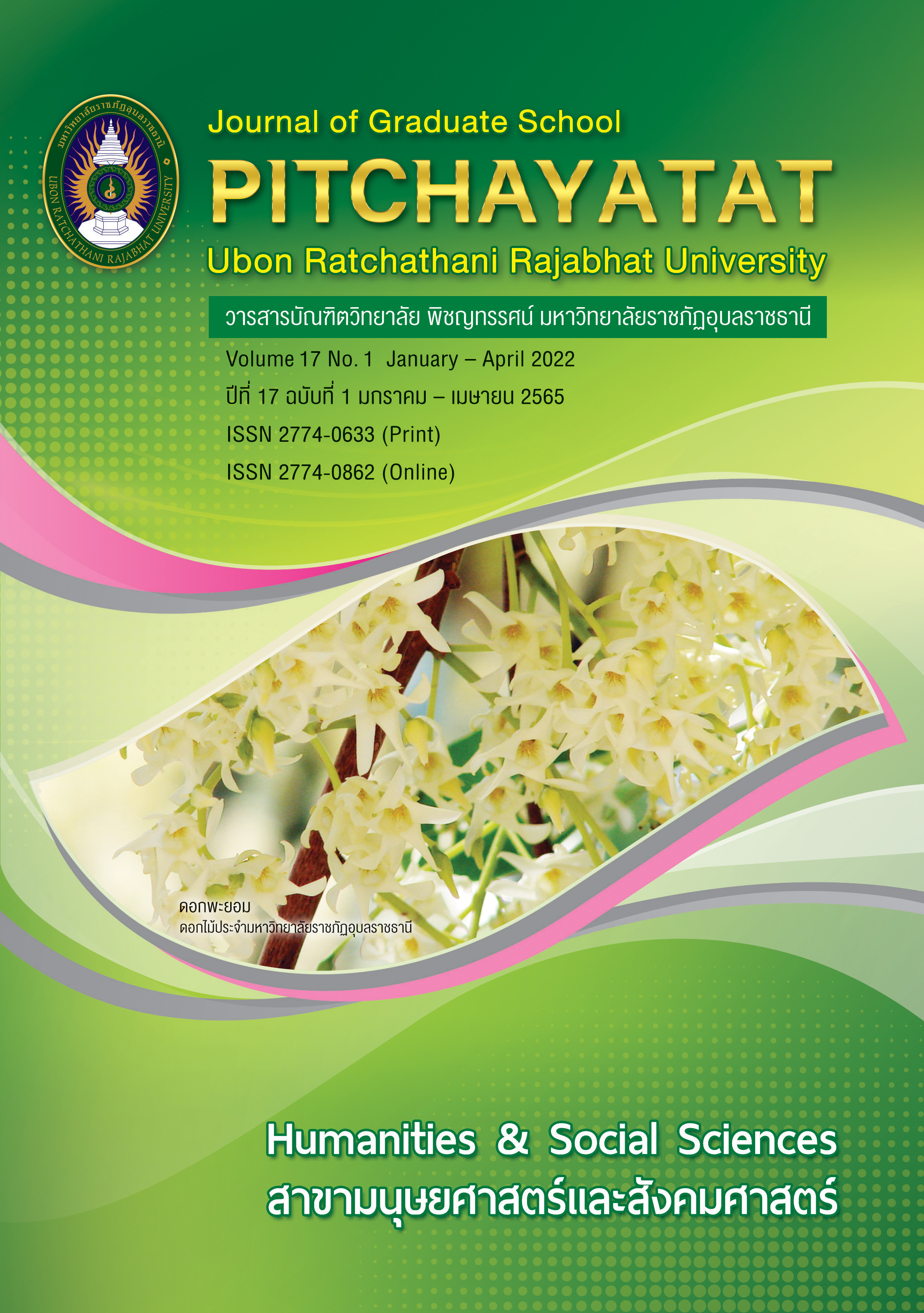ความสัมพันธ์ระหว่างภาวะผู้นำยุคดิจิทัลของผู้บริหารสถานศึกษากับแรงจูงใจในการปฏิบัติงานของครูในสังกัดสำนักงานเขตพื้นที่การศึกษาประถมศึกษาศรีสะเกษ เขต 2
คำสำคัญ:
ความสัมพันธ์, ภาวะผู้นำยุคดิจิทัล , แรงจูงใจในการปฏิบัติงานบทคัดย่อ
การวิจัยนี้มีวัตถุประสงค์เพื่อ 1) ศึกษาระดับภาวะผู้นำยุคดิจิทัลของผู้บริหารสถานศึกษา 2) ศึกษาระดับแรงจูงใจในการปฏิบัติงานของครู และ 3) ศึกษาความสัมพันธ์ระหว่างภาวะผู้นำยุคดิจิทัลของผู้บริหารสถานศึกษากับแรงจูงใจในการปฏิบัติงานของครูในสังกัดสำนักงานเขตพื้นที่การศึกษาประถมศึกษา ศรีสะเกษ เขต 2 กลุ่มตัวอย่าง ได้แก่ ผู้บริหารสถานศึกษาและครู จำนวน 309 คน ผู้บริหารสถานศึกษา จำนวน 36 คนและครูจำนวน 273 คน รวมทั้งสิ้น 309 คน ในสังกัดสำนักงานเขตพื้นที่การศึกษาประถมศึกษาศรีสะเกษ เขต 2 โดยการสุ่มแบบชั้นภูมิ เครื่องมือที่ใช้คือแบบสอบถาม สถิติที่ใช้ได้แก่ ร้อยละ ค่าเฉลี่ย ส่วนเบี่ยงเบนมาตรฐาน และค่าสัมประสิทธิ์สหสัมพันธ์ของเพียร์สัน
ผลการวิจัยพบว่า
- ภาวะผู้นำยุคดิจิทัลของผู้บริหารสถานศึกษาในสังกัดสำนักงานเขตพื้นที่การศึกษาประถมศึกษา ศรีสะเกษ เขต 2 ในภาพรวมพบว่า อยู่ในระดับมาก
- แรงจูงใจในการปฏิบัติงานของครู ในสังกัดสำนักงานเขตพื้นที่การศึกษาประถมศึกษาศรีสะเกษ เขต 2 ในภาพรวมพบว่า อยู่ในระดับมากทุกด้าน
- ภาวะผู้นำยุคดิจิทัลของผู้บริหารสถานศึกษากับแรงจูงใจในการปฏิบัติงานของครู ในสังกัด สำนักงานเขตพื้นที่การศึกษาประถมศึกษาศรีสะเกษ เขต 2 มีความสัมพันธ์กันในระดับปานกลาง อย่างมีนัยสำคัญทางสถิติที่ระดับ .01
เอกสารอ้างอิง
จิณณวัตร ปะโคทัง. ภาวะผู้นำยุคดิจิทัลสำหรับผู้บริหารสถานศึกษามืออาชีพ. อุบลราชธานี: ศิริธรรมออฟเซ็ท, 2561.
ดวงกมล สุริยะวงษา. ความสัมพันธ์ระหว่างพฤติกรรมภาวะผู้นำของผู้บริหารสถานศึกษากับความพึงพอใจในการปฏิบัติงานของครูในสถานศึกษาขั้นพื้นฐานช่วงชั้นที่ 1-2 สังกัดสำนักงานเขตพื้นที่การศึกษาประถมศึกษากาญจนบุรี เขต 3. กาญจนบุรี: วิทยาพนธ์ ครุศาสตรมหาบัณฑิต สาขาวิชาการบริหารการศึกษา มหาวิทยาลัยราชภัฏกาญจนบุรี, 2555.
ทินกร บัวชู. ภาวะผู้นำดิจิทัลของผู้บริหารสถานศึกษา. เพชรบุรี: มหาวิทยาลัยราชภัฏเพชรบุรี, 2562.
นารีรัตน์ บัตรประโคน. ความสัมพันธ์ระหว่างแรงจูงใจในการปฏิบัติงานของครูกับประสิทธิผลของโรงเรียนในสังกัดสำนักงานเขตพื้นที่การศึกษาประถมศึกษาบุรีรัมย์ เขต 3. บุรีรัมย์: วิทยานิพนธ์ ครุศาสตรมหาบัณฑิต สาขาวิชาการบริหารการศึกษา มหาวิทยาลับราชภัฏบุรีรัมย์, 2557.
บุษยมาส ผาดี. ภาวะผู้นำของผู้บริหารสถานศึกษาในศตวรรษที่ 21 ที่ส่งผลต่อแรงจูงใจในการปฏิบัติงานของครูสังกัดสำนักงานเขตพื้นที่การศึกษาประถมศึกษาระยอง เขต 1. จันทบุรี: วิทยานิพนธ์ ครุศาสตรมหาบัณฑิต สาขาวิชาการบริหารการศึกษา มหาวิทยาลัยราชภัฏรำไพพรรณี, 2563.
ประภาพรรณ รักเลี้ยง. หลักทฤษฎีและปฏิบัติการบริหารการศึกษา. พิษณุโลก: วิทยานิพนธ์ สาขาการบริหารการศึกษา คณะครุศาสตร์ มหาวิทยาลัยพิษณุโลก, 2556.
เพ็ญนภา ศรีภูธร. การศึกษาภาวะผู้นำเชิงสร้างสรรค์ของผู้บริหารสถานศึกษาขั้นพื้นฐาน สังกัดสำนักงานเขตพื้นที่การศึกษาประถมศึกษาระยอง. จันทบุรี: วิทยานิพนธ์ ครุศาสตรมหาบัณฑิต สาขาวิชาการบริหารการศึกษา มหาวิทยาลัยราชภัฏรำไพพรรณี, 2562.
ศิริวรรณ เสรีรัตน์ และคณะ. การจัดการและพฤติกรรมองค์การ. กรงเทพฯ: ธีระฟิล์มและไซเท็กซ์, 2550.
สุกันชญา แช่มชอย. การบริหารสถานศึกษาในยุคดิจิทัล. กรุงเทพฯ: สำนักพิมพ์แห่งจุฬาลงกรณ์มหาวิทยาลัย, 2561.
สุดารัตน์ วสุพลวิรุฬห์. ความสัมพันธ์ระหว่างแบบภาวะผู้นําของผู้บริหารกับแรงจูงใจในการปฏิบัติงานของครูและพนักงานราชการในศูนย์การศึกษา นอกระบบและการศึกษาตามอัธยาศัยอําเภอในเขตภาคกลาง.ราชบุรี: วิทยานิพนธ์ ครุศาสตรมหาบัณฑิต สาขาวิชาบริหารการศึกษา มหาวิทยาลัยราชภัฏหมู่บ้านจอมบึง, 2555.
สมใจ ลักษณะ. การพัฒนาประสิทธิภาพในการทำงาน. กรุงเทพฯ: โรงพิมพ์เพิ่มทรัพย์การพิมพ์, 2549.
Good, Carter V. The Human Organization: Its Management and Values. New York: McGraw- Hill Book Company, 1973.
Jung et al. Predicting unit performance by assessing transformational and transactional leadership. USA: American Psychological Association, 2003
Krejcie, and Morgan. Determining Sample Size for Research Activities. Educational and Psychological Measurement, 1970.
Wood, J. V. Self-esteem and the cognitive accessibility of strengths and weaknesses after failure. Journal of Personality and Social Psychology, 75, 1 (1998): 178-197.
ดาวน์โหลด
เผยแพร่แล้ว
รูปแบบการอ้างอิง
ฉบับ
ประเภทบทความ
สัญญาอนุญาต
ลิขสิทธิ์ (c) 2022 วารสารบัณฑิตวิทยาลัย พิชญทรรศน์ มหาวิทยาลัยราชภัฏอุบลราชธานี

อนุญาตภายใต้เงื่อนไข Creative Commons Attribution-NonCommercial-NoDerivatives 4.0 International License.
บทความทุกเรื่องได้รับการตรวจความถูกต้องทางวิชาการโดยผู้ทรงคุณวุฒิภายนอกอย่างน้อย 3 คน ความคิดเห็นในวารสารพิชญทรรศน์เป็นความคิดเห็นของผู้นิพนธ์มิใช่ความคิดเห็นของผู้จัดทำ จึงมิใช่ความรับผิดชอบของวารสารพิชญทรรศน์ และบทความในวารสารพิชญทรรศน์สงวนสิทธิ์ตามกฎหมายไทย การจะนำไปเผยแพร่ต้องได้รับอนุญาตเป็นลายลักษณ์อักษรจากกองบรรณาธิการ






